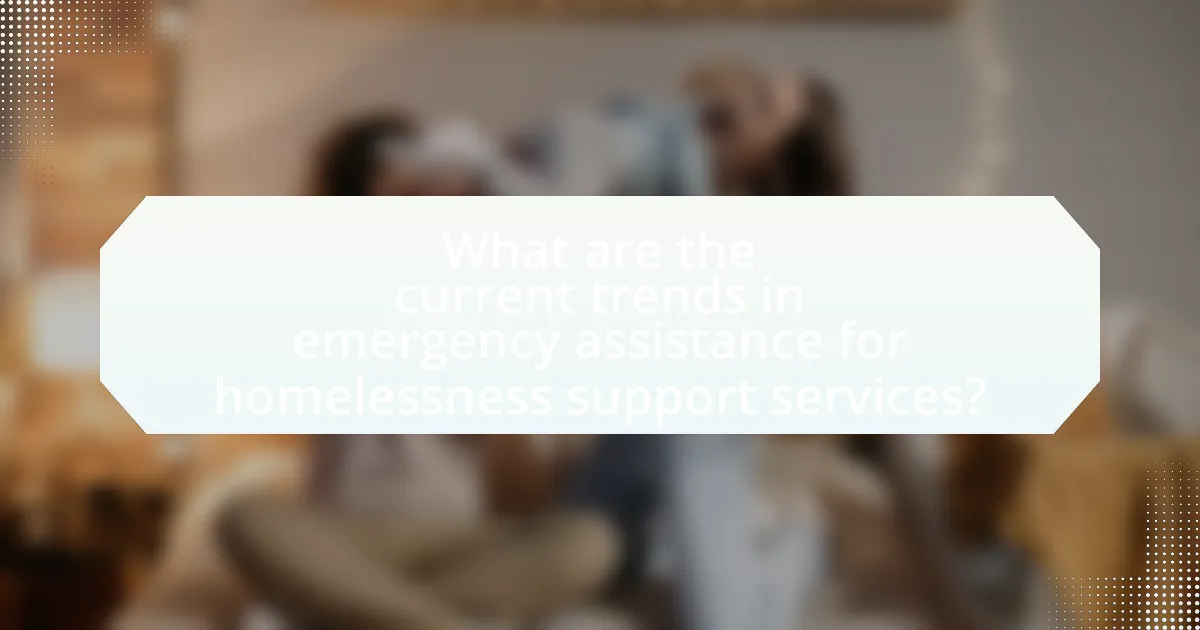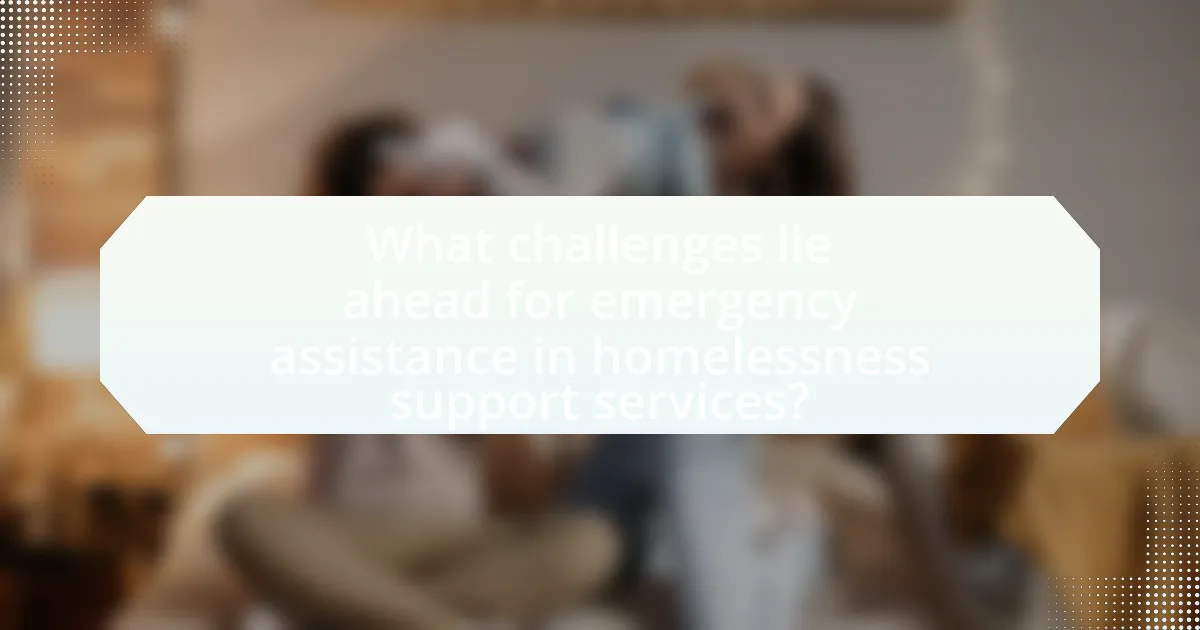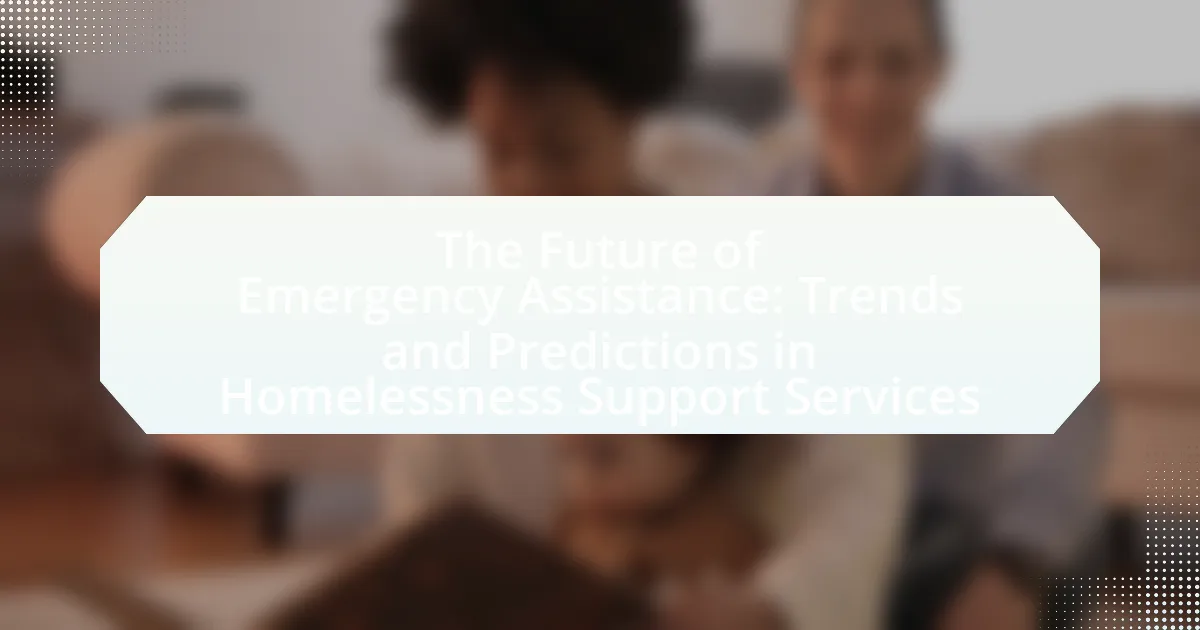The article focuses on the evolving landscape of emergency assistance within homelessness support services, highlighting current trends such as integrated service models, technological advancements, and a strong emphasis on prevention strategies. It examines how societal changes, economic instability, and public perception influence these trends, while also addressing the impact of policy changes and potential legislation on service delivery. Additionally, the article explores emerging models of support, community-based approaches, and the importance of partnerships in enhancing service effectiveness. Challenges such as funding shortages and systemic barriers are discussed, alongside best practices and data-driven strategies to improve outcomes for individuals experiencing homelessness.

What are the current trends in emergency assistance for homelessness support services?
Current trends in emergency assistance for homelessness support services include a shift towards integrated service models, increased use of technology for service delivery, and a focus on prevention strategies. Integrated service models combine housing assistance with health care, mental health services, and employment support, addressing the multifaceted needs of individuals experiencing homelessness. For instance, the U.S. Department of Housing and Urban Development (HUD) has emphasized the importance of coordinated entry systems that streamline access to various services. Additionally, technology is being leveraged to enhance service delivery through mobile applications and online platforms, allowing for real-time assistance and resource allocation. A report from the National Alliance to End Homelessness highlights that prevention strategies, such as rental assistance and mediation services, are increasingly prioritized to reduce the inflow of individuals into homelessness. These trends reflect a comprehensive approach aimed at not only providing immediate relief but also fostering long-term stability for those affected by homelessness.
How are societal changes influencing these trends?
Societal changes are significantly influencing trends in homelessness support services by increasing awareness and advocacy for systemic issues such as affordable housing and mental health care. For instance, the rise of social movements advocating for equity and justice has led to greater public and governmental focus on addressing the root causes of homelessness, resulting in policy shifts that prioritize preventive measures and comprehensive support systems. According to a report by the National Alliance to End Homelessness, communities that have adopted a Housing First approach, which emphasizes providing stable housing without preconditions, have seen a 30% reduction in homelessness rates. This demonstrates that societal shifts towards inclusivity and support for vulnerable populations are reshaping how emergency assistance is structured and delivered.
What role does economic instability play in shaping homelessness support services?
Economic instability significantly influences the development and allocation of homelessness support services. During periods of economic downturn, increased unemployment rates and reduced income levels lead to a higher demand for these services, prompting governments and organizations to adapt their strategies to address the growing needs. For instance, the 2008 financial crisis resulted in a 30% increase in homelessness in the United States, which forced local governments to expand emergency shelters and provide additional financial assistance programs. This correlation between economic conditions and homelessness support services underscores the necessity for responsive and flexible service frameworks that can effectively address the challenges posed by economic fluctuations.
How does public perception of homelessness affect support initiatives?
Public perception of homelessness significantly influences support initiatives by shaping funding, policy decisions, and community engagement. When the public views homelessness as a complex social issue requiring empathy and systemic solutions, support initiatives tend to receive more funding and political backing, as evidenced by studies showing that communities with higher awareness and understanding of homelessness often implement more comprehensive support programs. Conversely, negative perceptions, such as viewing homelessness as a personal failure, can lead to reduced funding and stigmatization of individuals experiencing homelessness, which hinders the effectiveness of support initiatives. Research from the National Alliance to End Homelessness indicates that public attitudes directly correlate with the success of local programs aimed at reducing homelessness, demonstrating the critical role of perception in shaping effective responses to this issue.
What technological advancements are impacting emergency assistance?
Technological advancements significantly impacting emergency assistance include mobile applications, artificial intelligence, and data analytics. Mobile applications facilitate real-time communication between service providers and individuals in need, allowing for quicker response times and resource allocation. Artificial intelligence enhances decision-making processes by predicting needs and optimizing service delivery based on historical data. Data analytics enables organizations to identify trends and allocate resources more effectively, improving overall service efficiency. For instance, a study by the Urban Institute found that data-driven approaches in homelessness services led to a 20% increase in successful placements into permanent housing.
How are digital platforms transforming access to homelessness support services?
Digital platforms are transforming access to homelessness support services by providing streamlined communication, resource availability, and real-time assistance. These platforms enable individuals experiencing homelessness to easily connect with service providers, access vital information about shelters, food resources, and healthcare services, and receive support through mobile applications and websites. For instance, a study by the National Alliance to End Homelessness highlights that digital tools have increased the efficiency of service delivery, allowing organizations to reach a broader audience and respond more quickly to urgent needs. Additionally, data from the U.S. Department of Housing and Urban Development indicates that online platforms have improved the coordination of services, leading to better outcomes for individuals seeking help.
What innovations in data collection are enhancing service delivery?
Innovations in data collection enhancing service delivery include the use of mobile applications, real-time data analytics, and machine learning algorithms. Mobile applications facilitate immediate data entry and access for service providers, allowing for timely responses to client needs. Real-time data analytics enable organizations to track service utilization and outcomes, improving resource allocation and program effectiveness. Machine learning algorithms analyze large datasets to identify trends and predict future service demands, thereby optimizing service delivery strategies. These innovations collectively contribute to more efficient and responsive homelessness support services.

What predictions can be made about the future of homelessness support services?
Predictions about the future of homelessness support services indicate a shift towards more integrated and holistic approaches. As cities face increasing homelessness rates, services are likely to focus on prevention, rapid rehousing, and mental health support, reflecting trends seen in successful models like the Housing First initiative. Data from the U.S. Department of Housing and Urban Development shows that communities implementing these strategies have seen significant reductions in homelessness, suggesting that future services will prioritize stable housing as a foundation for addressing other needs. Additionally, advancements in technology may enhance service delivery, allowing for better data collection and personalized support, which can lead to more effective interventions.
How might policy changes affect emergency assistance programs?
Policy changes can significantly impact emergency assistance programs by altering funding levels, eligibility criteria, and service delivery methods. For instance, a reduction in government funding can lead to decreased resources for shelters and food banks, resulting in fewer services available to those in need. Conversely, increased funding can enhance program capacity, allowing for expanded services and improved support for vulnerable populations. Additionally, changes in eligibility criteria, such as stricter income thresholds, can limit access for individuals who require assistance, thereby increasing homelessness rates. Historical data shows that during the 2008 financial crisis, policy shifts led to a surge in homelessness due to cuts in emergency assistance funding, highlighting the direct correlation between policy decisions and program effectiveness.
What potential legislation could reshape homelessness support services?
Potential legislation that could reshape homelessness support services includes the implementation of a Universal Housing Guarantee, which would ensure that all individuals have access to safe and affordable housing. This concept is supported by various studies indicating that stable housing significantly reduces homelessness rates and improves overall community health. Additionally, the expansion of the Housing First model, which prioritizes providing permanent housing without preconditions, has shown effectiveness in reducing homelessness, as evidenced by successful programs in cities like Salt Lake City and Houston. Furthermore, increased funding for mental health and addiction services through legislation could address underlying issues contributing to homelessness, as research indicates that a significant percentage of homeless individuals struggle with these challenges.
How can advocacy efforts influence future funding for these services?
Advocacy efforts can significantly influence future funding for homelessness support services by raising awareness and mobilizing public and political support. When advocacy groups effectively communicate the needs of the homeless population and the impact of support services, they can drive policy changes and increase funding allocations. For instance, studies have shown that advocacy campaigns that highlight success stories and data on the effectiveness of homelessness programs can lead to increased government budgets for these services, as seen in cities that have implemented comprehensive outreach strategies. Additionally, successful advocacy can result in partnerships with private organizations and philanthropic entities, further enhancing funding opportunities.
What emerging models of support are being developed?
Emerging models of support in homelessness assistance include Housing First, which prioritizes providing permanent housing without preconditions, and integrated service models that combine housing with health and social services. Housing First has been shown to reduce homelessness and improve health outcomes, as evidenced by studies such as the 2016 evaluation by the U.S. Department of Housing and Urban Development, which found significant reductions in homelessness among participants. Integrated service models, like the Pathways Housing First model, have demonstrated effectiveness in addressing the complex needs of individuals experiencing homelessness by offering comprehensive support tailored to individual circumstances.
How are community-based approaches changing the landscape of emergency assistance?
Community-based approaches are transforming emergency assistance by prioritizing local engagement and tailored support. These methods leverage the strengths and resources of local communities, enabling more effective responses to crises. For instance, studies show that community-led initiatives can reduce response times and improve resource allocation, as seen in the aftermath of natural disasters where local organizations mobilized faster than traditional agencies. Furthermore, community-based strategies foster trust and collaboration among residents, leading to more sustainable solutions for homelessness and other emergencies. This shift is evidenced by the increasing adoption of models that emphasize local partnerships, such as the Community Resilience Framework, which has been implemented in various regions to enhance emergency preparedness and response.
What role do partnerships between organizations play in future service models?
Partnerships between organizations are crucial in shaping future service models for homelessness support services. These collaborations enhance resource sharing, allowing organizations to combine expertise, funding, and outreach efforts, which leads to more comprehensive and effective service delivery. For instance, a study by the National Alliance to End Homelessness highlights that coordinated efforts between local governments, non-profits, and community organizations have resulted in a 30% reduction in homelessness in certain regions. This demonstrates that partnerships not only improve service efficiency but also create a more robust support network for individuals experiencing homelessness.

What challenges lie ahead for emergency assistance in homelessness support services?
The challenges ahead for emergency assistance in homelessness support services include funding shortages, increasing demand for services, and the need for coordinated care. Funding shortages are critical, as many programs rely on government and private donations, which can fluctuate, leading to inconsistent service availability. Increasing demand is evident, with the U.S. Department of Housing and Urban Development reporting a 2% rise in homelessness from 2020 to 2021, highlighting the growing need for immediate assistance. Additionally, the need for coordinated care among various service providers is essential to address the complex needs of individuals experiencing homelessness, yet many systems remain fragmented, complicating access to comprehensive support.
How can funding shortages impact service delivery?
Funding shortages can severely hinder service delivery by limiting the resources available for essential programs. When financial support is inadequate, organizations may face staff layoffs, reduced service hours, and diminished program offerings, which directly affect the quality and accessibility of services provided to those in need. For instance, a study by the National Alliance to End Homelessness found that a 10% reduction in funding can lead to a 20% decrease in the number of individuals served by homelessness support services. This illustrates that insufficient funding not only restricts operational capacity but also exacerbates the challenges faced by vulnerable populations, ultimately undermining the effectiveness of emergency assistance initiatives.
What strategies can organizations employ to mitigate funding challenges?
Organizations can mitigate funding challenges by diversifying their funding sources, which reduces reliance on a single revenue stream. This strategy includes seeking grants from multiple foundations, engaging in crowdfunding campaigns, and establishing partnerships with local businesses for sponsorships. For instance, a study by the National Alliance to End Homelessness highlights that organizations that utilize a mix of public, private, and philanthropic funding are more resilient during economic downturns. Additionally, implementing cost-effective operational practices, such as utilizing volunteers and optimizing resource allocation, can further enhance financial sustainability.
How do economic downturns affect the sustainability of support services?
Economic downturns significantly undermine the sustainability of support services by reducing funding and increasing demand for assistance. During economic recessions, government budgets often face cuts, leading to decreased financial support for programs aimed at helping vulnerable populations, including those experiencing homelessness. For instance, the 2008 financial crisis resulted in a 20% reduction in federal funding for homelessness assistance programs, which directly impacted service availability. Additionally, as unemployment rises during downturns, more individuals and families seek support services, creating a higher demand that existing resources struggle to meet. This dual pressure of reduced funding and increased demand jeopardizes the long-term viability of support services, making it challenging for them to operate effectively and serve those in need.
What barriers exist in reaching those in need of assistance?
Barriers in reaching those in need of assistance include lack of awareness, accessibility issues, and stigma. Many individuals experiencing homelessness are unaware of available services due to insufficient outreach efforts, which can lead to missed opportunities for support. Accessibility issues arise from physical barriers, such as transportation challenges and the location of services, making it difficult for individuals to reach assistance programs. Stigma surrounding homelessness can deter individuals from seeking help, as they may fear judgment or discrimination. According to the National Alliance to End Homelessness, these barriers significantly hinder effective outreach and support for vulnerable populations.
How do systemic issues contribute to the challenges faced by homeless individuals?
Systemic issues significantly contribute to the challenges faced by homeless individuals by creating barriers to access essential resources and services. Factors such as inadequate affordable housing, insufficient mental health support, and systemic discrimination exacerbate homelessness. For instance, the National Alliance to End Homelessness reports that a lack of affordable housing is the primary driver of homelessness, with over 7 million low-income renters facing severe housing cost burdens. Additionally, systemic failures in healthcare and social services often leave individuals without necessary support, leading to increased vulnerability. These systemic barriers not only hinder immediate assistance but also perpetuate cycles of poverty and instability among homeless populations.
What can be done to improve accessibility to emergency assistance programs?
To improve accessibility to emergency assistance programs, implementing streamlined application processes is essential. Simplifying forms and reducing documentation requirements can significantly lower barriers for individuals seeking help. For instance, the National Alliance to End Homelessness reports that complex application procedures often deter those in need from accessing services. Additionally, increasing outreach efforts through community partnerships can ensure that information about available programs reaches underserved populations. Research indicates that targeted outreach can enhance program participation by up to 30%, demonstrating the effectiveness of proactive engagement strategies.
What best practices can enhance the effectiveness of homelessness support services?
To enhance the effectiveness of homelessness support services, implementing a client-centered approach is essential. This practice prioritizes the individual needs and preferences of those experiencing homelessness, leading to more tailored and effective interventions. Research indicates that programs utilizing a client-centered model, such as Housing First, have significantly improved housing stability and reduced homelessness rates. For instance, a study published in the American Journal of Public Health found that Housing First programs resulted in a 74% reduction in homelessness among participants, demonstrating the efficacy of personalized support strategies. Additionally, integrating wraparound services, such as mental health care and job training, further supports individuals in achieving long-term stability, as evidenced by various successful case studies across multiple cities.
How can organizations implement data-driven approaches to improve outcomes?
Organizations can implement data-driven approaches to improve outcomes by leveraging analytics to inform decision-making and optimize resource allocation. By collecting and analyzing data on service usage, client demographics, and outcomes, organizations can identify trends and areas for improvement. For instance, a study by the Urban Institute found that data-driven interventions in homelessness services led to a 20% increase in successful housing placements. This evidence demonstrates that utilizing data not only enhances operational efficiency but also significantly improves the effectiveness of support services in addressing homelessness.
What role does community engagement play in successful support initiatives?
Community engagement is crucial for the success of support initiatives as it fosters trust, collaboration, and responsiveness to the needs of those being served. Engaged communities are more likely to participate actively in programs, leading to higher effectiveness and sustainability of support services. For instance, a study by the National Alliance to End Homelessness found that initiatives involving community input and participation resulted in a 30% increase in service utilization among homeless populations. This demonstrates that when communities are involved, support initiatives are better tailored to address specific local challenges, ultimately enhancing their impact and success.

Leave a Reply